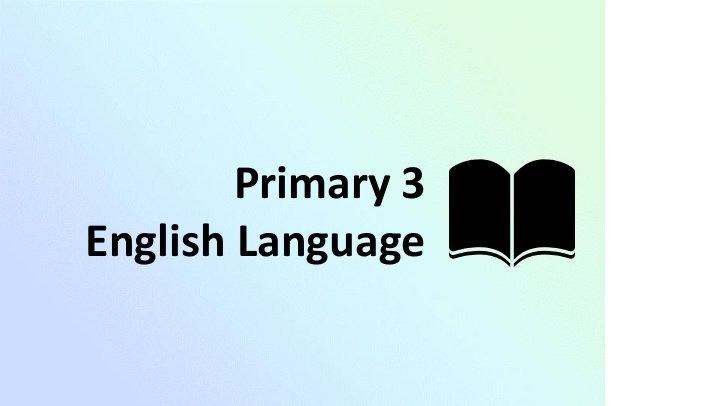



Primary 3 English Language
Content • Joy of Learning • Unit Coverage • Level Focuses • Strategies for Learning • Assessment • Home Support
Joy of Learning Newspapers Reading of newspapers Objectives: - to encourage children to read current affairs - to promote reading of a variety of text types Post-reading activities, such as journals, are designed to instill critical reading skills and reflection
Joy of Learning Charlotte’s Web Literature text as a supplementary reading material to: - promote reading for enjoyment and reading to learn - strengthen vocabulary knowledge and complex sentence structures - deepen reading comprehension skills with in-depth analysis of characters and plots in the story
Unit Coverage Term 1 Term 2 Term 3 Term 4 Fearless Phil Predators and Unusual Plants Prince Zak and Prey the Wise Frog There’s a Boy The Gruffalo The Stars of Spilt Milk Chek Jawa Under the Bed Camille and the Sunflower
Level Focuses Oracy Writing Speak confidently by having Generate and select ideas for good posture, eye contact and writing and representing for a smiles variety of purposes using Tell- Speak with common sentence Show strategy starters with ease and confidence Able to justify, elaborate and make comparison
Strategies for Learning SSR – Sustained Silent Reading 10 minutes of silent reading Sharing of book read by teacher or students Promote reading for enjoyment and sharing of good books read Developing Language Skills SR – Supported Reading Vocabulary words (Narrative texts) Grammar items Reading for understanding and enjoyment Sentence manipulation Making prediction and questioning Whole-text study Reading strategies Writing Process Text types Text features KWL – Know-Want to Know-Learnt (Non-fiction texts) Relate a new topic or information to what they already know Anticipate what they will be reading about Get involved in the text by having students look for information they want to find
Comprehension Read the text a few times to increase understanding. Using reading strategies such as retelling , questioning , inferring , visualising , predicting and evaluating to deepen understanding. Use prior knowledge to make connections with the text and make sense. Look up definitions of unfamiliar words in the text. Use TAPS ( T enses, A greement, P unctuation and S pelling) to check accuracy of written answers.
Continuous Writing Examine the question carefully - e.g. Write a composition of at least 120 words about a rainy day (theme) Use one or more of the 3 given pictures to develop a plot Expand main ideas with details Explore more on the characters – senses, thoughts and feelings, actions and behaviour Use Tell-Show Strategies: - describe the scenes and events as if they are taking place in real time - use vivid descriptions, actions and dialogues to put the readers in the story - show the characters’ emotions through words and actions, not tell
Oral Reading Aloud Pronounce every word accurately with clear ending sounds. Read fluently, pausing at the right part of the sentences. Vary tone, pitch and pace appropriately to convey the emotions of the characters in the text. Read clearly and loudly.
Oral Stimulus-based Conversation Use the pictures to engage in a conversation. State choices with explanations. Elaborate on ideas by giving opinions and reasons, describe thoughts and personal experiences, and suggest possible actions. Use a wide range of vocabulary and accurate language structures. Speak confidently and coherently. Speak loudly and clearly to be heard and understood.
Assessment Term Components Marks Duration 1 Listening Comprehension: 14 30 min • Picture matching • Picture sequencing • Note-taking • Comprehension MCQ 2 Language Use and Comprehension: 40 1 h • Vocabulary MCQ • Grammar MCQ • Grammar Cloze • Editing for Spelling and Grammar • Sentence Combining • Comprehension 3 Continuous Writing 20 50 min
Semestral Assessment Paper Components Marks Weighting Duration Composition 1 20 20% 50 min Language Use and 2 50 50% 1h 15 min Comprehension Listening 3 14 14% Approximately Comprehension 30 min Reading Aloud 4 16 16% Approximately Stimulus-based 10 min Conversation Total 100 100%
Home Support Provide a wide variety of age-appropriate books for daily reading. Expose children to different authors and genres. Read with, not read for, the child to involve him/her in reading and understanding the text. Set mini authentic writing tasks (e.g. diary, making a shopping list and taking telephone messages) to increase confidence and interest in writing. Model spoken Standard English Language. Set a routine for homework and revision – recalling improves retention. Learn spelling and dictation timely.
Thanks! Happy 2020
Recommend
More recommend